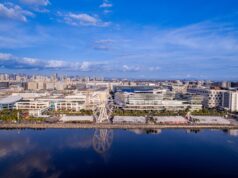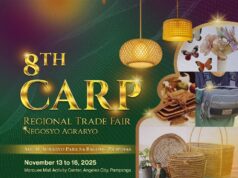LUBAO, Pampanga—The ninth President of the Philippines has a museum and library now to his name.
Built right here in his hometown after his death in 1997, the President Diosdado P. Macapagal Museum and Library (PDPMML) ended 12 years of having no museum of his own, according to his eldest daughter, former Vice Governor Cielo Macapagal-Salgado.
“He was the only (deceased) President who did not have a museum in his birthplace,” she noted
But more importantly, the PDPMML fulfilled his dream.
“A modest museum was what he liked, not for himself but as a gift to the youth, especially for poor children so they will be inspired, ” Salgado said.
That dedication resonates from a granite wall with this message on silver-plated letters: “To the Filipino youth for whom we strive to build an esteemed, prosperous and a happy nation.”
It was the same dedication he wrote on his presidential memoir, “A Stone for the Edifice,” in 1968.
“We’re very happy. It was his dream,” she said of PDPMML.
“We” meant she, brother Arturo and half-siblings President Gloria Macapagal-Arroyo and Diosdado Jr.
Still a work-in-progress in time for their father’s 100th birth anniversary on Sept. 28, 2010, the project is supervised by Arturo on behalf of the family and the President Diosdado Macapagal Foundation chaired by Dr. Alejandro Roces. They worked on it, on savings and donations of relatives, after the National Historical Institute confirmed the lack of funds to do it, Salgado said. President Arroyo led inauguration rites last September.
The site has billboard in brown, the international color for tourism directional signs.
FROM A HUT
The idea for the PDPMML actually began in 1990 when the Department of Education built a replica of a nipa hut where Macapagal, the second child in a brood of four, was born and raised. It stood on the De Guzman land which the friends of Macapagal bought as a gift to him after his presidency.
The museum’s concrete structure evolved from a one-room office that Cielo built behind the hut. It was a President’s son, then Sen. Ramon Magsaysay Jr., who helped expand the office into a future museum. The Department of Public Works and Highways built a two-storey building out of the P1 million received from the senator’s pork barrel. Along the driveway, the NHI later made a wall relief summarizing the high points in Macapagal’s life.
Work for the full-blown museum and library began last May, with the family taking in Mary Anne Venturina-Bulanadi as curator and Erlita Mendoza as chief researcher and writer. Both work as researchers for the Center for Inter-Cultural Studies of the University of Santo Tomas, the alma mater of Macapagal.
Already installed within the nipa hut and the concrete building are panels with stories and photographs that tell the life of Macapagal.
Mendoza went past beyond the man’s almost iconic tag—Poor Boy from Lubao—by presenting the narratives in five chapters: Macapagal as a child; poet, zarzuelista and law student; lawyer, family man and guerilla; as assemblyman, vice president and president; and stateman and elder.
Mendoza managed to put in the crucial details of the man’s hard-fought struggle against poverty. Among the important files is an autobiography that Macapagal contributed for the monograph written by his daughter-in-law, Ma. Therese, for a doctoral course in 1987. Mendoza found this recently.
“Apong Dadong’s life spoke of how life can be a gift and how a life can make a difference,” she said.
Providential or not, as his name meant—Diosdado, meaning gift of God— there were always kindred souls at every twist in his life. Among others, there was Dr. Clemente Puno who treated him for dysentery , Benigno Fajardo who introduced him to Don Honorio Ventura who, in turn, helped him finish law school. Of course, there were his grandmother Escolastica and his mother Romana who, in their enterprising ways, made life bearable for the children.
In hunger and want, and later, high stature and power, Mendoza said the constant characters in Macapagal were respect for elders, fulfilling responsibilities and high regard for education.
“He held education as a legacy, a way out of poverty. With it, he was not intimidated by the trials in life,” she said.
The museum has also reintroduced a narrative on Purita de la Rosa, Macapagal’s first wife. She died of tuberculosis after the war, leaving Salgado and her brother in the care of relatives in Floridablanca.
“[Purita’s] not anymore marginalized. It’s like she’s gone home. She’s home,” Mendoza said.
Bulanadi said the PDPMML had been “curated carefully to be truthful to the reading public.”
The “Macapagal, the President” corner shows exact replicas of the table and chair he used in Malacanang. His presidential seal has 53 stars for the existing provinces during his term in 1961-1965. The Philippine flag and presidential flag were prepared with permission from Malacanang.
Some memorabilias are being obtained or borrowed from the donations that Macapagal and his second wife, Dr. Evangelina Macaraeg, made to the Malacanang Museum and Library, UST’s Museum of Arts, Foundation for Lingap Kapampangan and the Angeles University Foundation.
The royal lineage of Macapagal to Lakandula or how he is related to a Don Juan who helped the Spanish colonial government end the Maniago revolts against forced labor have yet to be fully explored.
Built right here in his hometown after his death in 1997, the President Diosdado P. Macapagal Museum and Library (PDPMML) ended 12 years of having no museum of his own, according to his eldest daughter, former Vice Governor Cielo Macapagal-Salgado.
“He was the only (deceased) President who did not have a museum in his birthplace,” she noted
But more importantly, the PDPMML fulfilled his dream.
“A modest museum was what he liked, not for himself but as a gift to the youth, especially for poor children so they will be inspired, ” Salgado said.
That dedication resonates from a granite wall with this message on silver-plated letters: “To the Filipino youth for whom we strive to build an esteemed, prosperous and a happy nation.”
It was the same dedication he wrote on his presidential memoir, “A Stone for the Edifice,” in 1968.
“We’re very happy. It was his dream,” she said of PDPMML.
“We” meant she, brother Arturo and half-siblings President Gloria Macapagal-Arroyo and Diosdado Jr.
Still a work-in-progress in time for their father’s 100th birth anniversary on Sept. 28, 2010, the project is supervised by Arturo on behalf of the family and the President Diosdado Macapagal Foundation chaired by Dr. Alejandro Roces. They worked on it, on savings and donations of relatives, after the National Historical Institute confirmed the lack of funds to do it, Salgado said. President Arroyo led inauguration rites last September.
The site has billboard in brown, the international color for tourism directional signs.
FROM A HUT
The idea for the PDPMML actually began in 1990 when the Department of Education built a replica of a nipa hut where Macapagal, the second child in a brood of four, was born and raised. It stood on the De Guzman land which the friends of Macapagal bought as a gift to him after his presidency.
The museum’s concrete structure evolved from a one-room office that Cielo built behind the hut. It was a President’s son, then Sen. Ramon Magsaysay Jr., who helped expand the office into a future museum. The Department of Public Works and Highways built a two-storey building out of the P1 million received from the senator’s pork barrel. Along the driveway, the NHI later made a wall relief summarizing the high points in Macapagal’s life.
Work for the full-blown museum and library began last May, with the family taking in Mary Anne Venturina-Bulanadi as curator and Erlita Mendoza as chief researcher and writer. Both work as researchers for the Center for Inter-Cultural Studies of the University of Santo Tomas, the alma mater of Macapagal.
Already installed within the nipa hut and the concrete building are panels with stories and photographs that tell the life of Macapagal.
Mendoza went past beyond the man’s almost iconic tag—Poor Boy from Lubao—by presenting the narratives in five chapters: Macapagal as a child; poet, zarzuelista and law student; lawyer, family man and guerilla; as assemblyman, vice president and president; and stateman and elder.
Mendoza managed to put in the crucial details of the man’s hard-fought struggle against poverty. Among the important files is an autobiography that Macapagal contributed for the monograph written by his daughter-in-law, Ma. Therese, for a doctoral course in 1987. Mendoza found this recently.
“Apong Dadong’s life spoke of how life can be a gift and how a life can make a difference,” she said.
Providential or not, as his name meant—Diosdado, meaning gift of God— there were always kindred souls at every twist in his life. Among others, there was Dr. Clemente Puno who treated him for dysentery , Benigno Fajardo who introduced him to Don Honorio Ventura who, in turn, helped him finish law school. Of course, there were his grandmother Escolastica and his mother Romana who, in their enterprising ways, made life bearable for the children.
In hunger and want, and later, high stature and power, Mendoza said the constant characters in Macapagal were respect for elders, fulfilling responsibilities and high regard for education.
“He held education as a legacy, a way out of poverty. With it, he was not intimidated by the trials in life,” she said.
The museum has also reintroduced a narrative on Purita de la Rosa, Macapagal’s first wife. She died of tuberculosis after the war, leaving Salgado and her brother in the care of relatives in Floridablanca.
“[Purita’s] not anymore marginalized. It’s like she’s gone home. She’s home,” Mendoza said.
Bulanadi said the PDPMML had been “curated carefully to be truthful to the reading public.”
The “Macapagal, the President” corner shows exact replicas of the table and chair he used in Malacanang. His presidential seal has 53 stars for the existing provinces during his term in 1961-1965. The Philippine flag and presidential flag were prepared with permission from Malacanang.
Some memorabilias are being obtained or borrowed from the donations that Macapagal and his second wife, Dr. Evangelina Macaraeg, made to the Malacanang Museum and Library, UST’s Museum of Arts, Foundation for Lingap Kapampangan and the Angeles University Foundation.
The royal lineage of Macapagal to Lakandula or how he is related to a Don Juan who helped the Spanish colonial government end the Maniago revolts against forced labor have yet to be fully explored.




